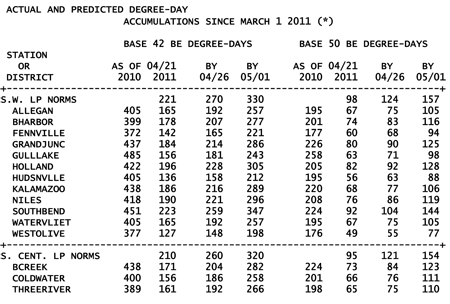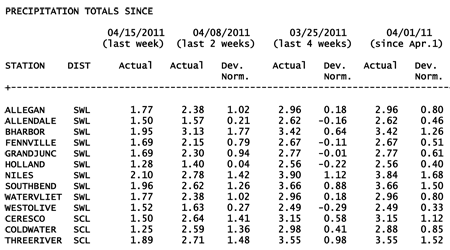Southwest Michigan field crop report April 28, 2011
A wet and cold spring has crop growth slowing down and producers feeling the pressure of the continuing wet conditions.
Weather – wet and cold spring continues
Current normal accumulations of Base 42 GDD’s would be 9.8 this week, 12 next week. The normal accumulations of Base 50 GDD’s (warm season plants) would be 5.2 this week and 6.6 next week. We can use the “normal GDD’s per day” values to estimate the number of days it would take to catch back up to the 30-year average. In the case of Base 50 GDD’s in the Kalamazoo area, we are approximately at 68 GDD’s, about five to six day’s average days behind normal since March 1.

Precipitation summary
The area has received somewhat heavier than normal precipitation levels over the last couple of weeks, particularly in the southern portion of the region, which is about 0.5 to 1.5 inches above normal for the month of April. With almost the entire area receiving at least 1.5 inches of precipitation last week, field operations are now at a complete standstill.

Field conditions range from wet to standing water across most of the region. With another week of wet weather expected, field operations have been slow to get started in southwest Michigan. Soil temperatures are ranging from the 50’s and lower 60’s to the 40’s at night. You can check the soil temperatures in your area on the web at Enviro-weather weather stations, and then by clicking on the Advanced weather tab along the top of the page.
The 6 to 10 day outlook shows the southwest region to be in the above normal precipitation zone, with some moderation to near normal in the 8 to 14 day outlook.
Alfalfa growth has remained slow with crop heights in the 2 to 4 inch range. So far there have been no signs of first instar alfalfa weevil feeding. Competitive annual weed growth has been slow to start as well.
Wheat has also continued to be growing slowly. Winter annual weed growth has picked up a tick in the fields, and should be watched for competition in the next couple of weeks. The Purdue entomologists report that armyworm moth catches have been high in Kentucky and southern Indiana. The wet weather we are currently experiencing has significant potential to carry moths from this area up into southern Michigan.
Corn and soybean producers are beginning to feel the pressure of the continuing wet conditions and are looking to get some corn into the ground. Conditions are too wet to allow for field work, and are likely to stay that way for the rest of the week. Winter annual weeds continue to grow. Black cutworm moths are moving up through Indiana, with intensive moth catches reported as far north as Fort Wayne. The southerly winds are likely to carry black cutworm moths up into our area soon. After an intensive moth catch, eggs begin to hatch around 90 GDD’s with early instar leaf feeding occurring until around the 300 GDD mark. Scouting should begin as we approach 300 GDD’s Base 50 for larvae and clipping damage to corn or soybeans. Fields that have heavy winter annual weed growth are the most likely to have black cutworm egg deposition. Consider applying a burn-down herbicide program or light tillage if the winter annual weeds are likely to get too far ahead of the tillage and planting operations. There have been some concerns about switching to shorter day maturity corn in the far southern portions of the state if the wet conditions continue.
Glyphosate resistant Palmer Amaranth
Christy Sprague has developed a Palmer Amaranth Identification and Glyphosate Resistant Palmer Amaranth Control Guide for growers in St. Joseph County to use, and for other growers in the area to review. She is recommending that growers consider using a pre-emergence weed control program followed by a post emergent program in corn and soybeans if you think that you have the weed species. MSU weed control educators would be interested in tracking pigweed species that are not readily controlled with applications of glyphosate in southwest Michigan this summer. Don’t forget, the MSU Weed Control Guide is available on-line at the MSU Weeds web site.
2-ee labels for Brown Marmorated Stink Bug Control in Michigan
Chris DiFonzo has developed a factsheet for Brown Marmorated Stink Bugs. The insect was found in Elkhart, Indiana, and in Berrien and Eaton counties in southern Michigan last fall. Chris does not believe that the pest will become a problem in field crops right away in Michigan, but announced in a recent “Fonz Facts” e-mail that Colbalt, Lorsban (any crops on the label) and Acephate (soybeans and drybeans) have 2ee Labels for BMSB control in Michigan.



 Print
Print Email
Email


